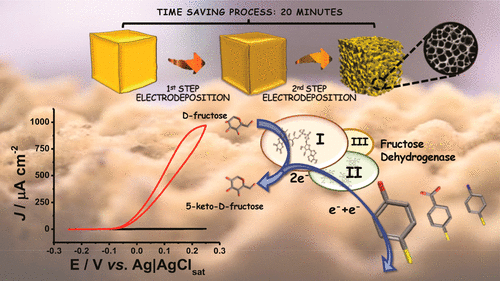当前位置:
X-MOL 学术
›
Anal. Chem.
›
论文详情
Our official English website, www.x-mol.net, welcomes your
feedback! (Note: you will need to create a separate account there.)
Highly Sensitive Membraneless Fructose Biosensor Based on Fructose Dehydrogenase Immobilized onto Aryl Thiol Modified Highly Porous Gold Electrode: Characterization and Application in Food Samples
Analytical Chemistry ( IF 6.7 ) Pub Date : 2018-08-27 00:00:00 , DOI: 10.1021/acs.analchem.8b03093 Paolo Bollella 1 , Yuya Hibino 2 , Kenji Kano 2 , Lo Gorton 3 , Riccarda Antiochia 1
Analytical Chemistry ( IF 6.7 ) Pub Date : 2018-08-27 00:00:00 , DOI: 10.1021/acs.analchem.8b03093 Paolo Bollella 1 , Yuya Hibino 2 , Kenji Kano 2 , Lo Gorton 3 , Riccarda Antiochia 1
Affiliation

|
In this paper we present a new method to electrodeposit highly porous gold (h-PG) onto a polycrystalline solid gold electrode without any template. The electrodeposition is carried out by first cycling the electrode potential between +0.8 and 0 V in 10 mM HAuCl4 with 2.5 M NH4Cl and then applying a negative potential for the production of hydrogen bubbles at the electrode surface. After that the modified electrode was characterized in sulfuric acid to estimate the real surface area (Areal) to be close to 24 cm2, which is roughly 300 times higher compared to the bare gold electrodes (0.08 cm2). The electrode was further incubated overnight with three different thiols (4-mercaptobenzoic acid (4-MBA), 4-mercaptophenol (4-MPh), and 4-aminothiophenol (4-APh)) in order to produce differently charged self-assembled monolayers (SAMs) on the electrode surface. Finally a fructose dehydrogenase (FDH) solution was drop-cast onto the electrodes. All the modified electrodes were investigated by cyclic voltammetry both under nonturnover and turnover conditions. The FDH/4-MPh/h-PG exhibited two couples of redox peaks for the heme c1 and heme c2 of the cytochrome domain of FDH and as well as a well pronounced catalytic current density (about 1000 μA cm–2 in the presence of 10 mM fructose) due to the presence of −OH groups on the electrode surface, which stabilize and orientate the enzyme layer on the electrode surface. The FDH/4-MPh/h-PG based electrode showed the best analytical performance with an excellent stability (90% retained activity over 90 days), a detection limit of 0.3 μM fructose, a linear range between 0.05 and 5 mM, and a sensitivity of 175 ± 15 μA cm–2 mM–1. These properties were favorably compared with other fructose biosensors reported in the literature. The biosensor was successively tested to quantify the fructose content in food and beverage samples. No significant interference present in the sample matrixes was observed.
中文翻译:

基于果糖脱氢酶的高灵敏度无膜果糖生物传感器固定在芳基硫醇修饰的高多孔金电极上:表征及在食品样品中的应用
在本文中,我们提出了一种在没有任何模板的情况下将高孔隙度金(h-PG)电沉积到多晶固体金电极上的新方法。电沉积是通过首先在带有2.5 M NH 4 Cl的10 mM HAuCl 4中在+0.8至0 V之间循环电极电势,然后施加负电势以在电极表面产生氢气泡来进行的。之后,用硫酸对改性电极进行表征,以估计其实际表面积(A real)接近24 cm 2,这比裸金电极(0.08 cm 2)高约300倍。)。将电极与三种不同的硫醇(4-巯基苯甲酸(4-MBA),4-巯基苯酚(4-MPh)和4-氨基硫酚(4-APh))进一步孵育过夜,以产生带电不同的自组装单层(SAMs)在电极表面上。最后,将果糖脱氢酶(FDH)溶液滴铸到电极上。在非周转和周转条件下,都通过循环伏安法研究了所有改性电极。FDH / 4-MPh / h-PG在FDH的细胞色素结构域的血红素c 1和血红素c 2上表现出两对氧化还原峰,并具有明显的催化电流密度(约1000μAcm –2在10 mM果糖的存在下),这是由于电极表面上存在-OH基团,该基团稳定并定向了电极表面上的酶层。基于FDH / 4-MPh / h-PG的电极表现出最佳的分析性能,具有出色的稳定性(在90天内保留90%的活性),0.3μM果糖的检出限,0.05至5 mM的线性范围以及灵敏度为175±15μAcm –2 mM –1。这些特性与文献中报道的其他果糖生物传感器相比具有优势。对生物传感器进行了连续测试,以量化食品和饮料样品中的果糖含量。在样品基质中没有观察到明显的干扰。
更新日期:2018-08-27
中文翻译:

基于果糖脱氢酶的高灵敏度无膜果糖生物传感器固定在芳基硫醇修饰的高多孔金电极上:表征及在食品样品中的应用
在本文中,我们提出了一种在没有任何模板的情况下将高孔隙度金(h-PG)电沉积到多晶固体金电极上的新方法。电沉积是通过首先在带有2.5 M NH 4 Cl的10 mM HAuCl 4中在+0.8至0 V之间循环电极电势,然后施加负电势以在电极表面产生氢气泡来进行的。之后,用硫酸对改性电极进行表征,以估计其实际表面积(A real)接近24 cm 2,这比裸金电极(0.08 cm 2)高约300倍。)。将电极与三种不同的硫醇(4-巯基苯甲酸(4-MBA),4-巯基苯酚(4-MPh)和4-氨基硫酚(4-APh))进一步孵育过夜,以产生带电不同的自组装单层(SAMs)在电极表面上。最后,将果糖脱氢酶(FDH)溶液滴铸到电极上。在非周转和周转条件下,都通过循环伏安法研究了所有改性电极。FDH / 4-MPh / h-PG在FDH的细胞色素结构域的血红素c 1和血红素c 2上表现出两对氧化还原峰,并具有明显的催化电流密度(约1000μAcm –2在10 mM果糖的存在下),这是由于电极表面上存在-OH基团,该基团稳定并定向了电极表面上的酶层。基于FDH / 4-MPh / h-PG的电极表现出最佳的分析性能,具有出色的稳定性(在90天内保留90%的活性),0.3μM果糖的检出限,0.05至5 mM的线性范围以及灵敏度为175±15μAcm –2 mM –1。这些特性与文献中报道的其他果糖生物传感器相比具有优势。对生物传感器进行了连续测试,以量化食品和饮料样品中的果糖含量。在样品基质中没有观察到明显的干扰。




















































 京公网安备 11010802027423号
京公网安备 11010802027423号